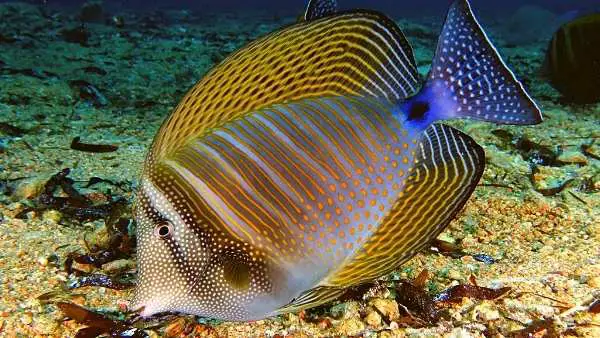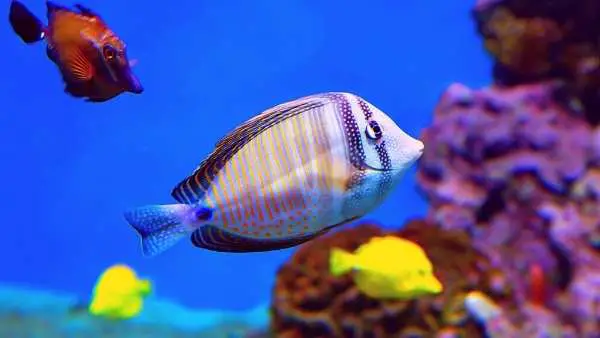Sailfin Tangs are quite possibly the most unique and awesome-looking fish you could introduce to your saltwater aquarium. Not only are they coated in incredibly bright colors and brilliant patterns, but their actual shape really is something to be admired too.
Sailfins originate from Oceania, and more specifically, the Indian Ocean and the South Pacific Ocean. Common names they have adopted over the years are sail fin fish, sailfin surgeonfish, Pacific Sailfin Tang, Ringed Tang, Striped Tang, and its scientific name is Zebrasoma veliferum – which is a pretty awesome name!

These incredible fish, who are often mistakenly named a Desjardin’s Sailfin Tang, are not only as stunning as saltwater fish get, but they are relatively low maintenance for a Tang species and are perfect for someone looking into Tang ownership and beginner hobbyists alike. They are peaceful natured, tough little critters, reef-safe, compatible with many different types of fish, and more importantly, less prone to diseases than most other Tangs.
A minor downfall when it comes to the incredible Caudal Fins these fish have (which is why they have adopted the cool Sailfin name) is in making sure you handle them with caution as they have sharp and almost scalpel-like spines running along the top of the fins. These are utilized when the fish are defending themselves and their territories in the wild. So, make sure you do not end up grabbing one by accident without any protection on your hands; otherwise, you could find yourself in a significant amount of pain!
Size and Appearance
What sets these Tangs apart from many of their other family members is their dorsal and anal fins being significantly larger, which is why they have an almost disk-shaped looking body. It sure is a sight to behold when you see their fins at full extension – their body nearly doubles in size, and the height is almost the same size as the width of the fish.
Sailfin Tangs can also grow quite large, especially for this type of species, meaning they should be kept in a sensibly sized aquarium, and not one that is too small for them to thrive in – fish can be unhappy too! They will occupy every single area of the tank and enjoy swimming out in the open as much as they enjoy holes and caves to hide in equally.
Tank Requirements and Additional Information
- The minimum tank size must be 180 Gallons (965 Liters).
- They are prone to some diseases; however, they are much less prone than other Tang species.
- Typical diseases include Ich (Ick) and HLLE (Head and Lateral Line Erosion).
- They are certainly beginner compatible, although you are probably not a beginner if you have a tank that is the size needed for these types of fish.
- The maximum size a Sailfish Tang can grow to is 15.7 inches (40 cm) in length.
- They certainly are reef compatible.
- Once they reach a large enough size, you can introduce them to a predator tank or even introduce a predator fish to their tank.
- Their care level is not particularly high. They require less maintenance than most other Tangs; however, there are some special requirements.
- The pH level of your tank should be 8.1 to 8.4.
- The temperature of your tank should be between 24°C to 28°C (75.2°F to 82.4°F).
- They will need plenty of places to hide, such as holes and caves.
- The ideal number per tank should be one; they will do much better being kept singularly. They can be kept with other Tangs, although do so with care and caution.
Feeding
Despite being low maintenance, they do have specific feeding requirements. They usually spend their time pecking at the sand bed and rocks. They are omnivores and primarily accept a mixture of frozen foods, live foods, and algae-based foods. If they have a healthy and balanced diet, they will undoubtedly thrive and be at a much lower risk of contracting diseases.

This diet should primarily consist of vegetable-based foods as the nutrients will help prevent Head and Lateral Line Erosion. They are also quick eaters, so it is important you are providing enough food for the entire tank and not just these Tangs; otherwise, the rest of your community might go hungry!
When it comes to them naturally consuming food, they will enjoy grazing on algae, seaweeds, diatoms, detritus, and filamentous algae during the day and will accept the other foods mentioned during tank feeding times. They will happily devour live foods, frozen foods, flaked foods, and nori (nori is dried seaweed).
Acclimatization
The acclimatization for the Sailfins is much the same for all the other Tangs too – place your newly acquired fish in your bucket and drip acclimate for around 1 hour (60 minutes) at a drip rate of 3 per second. This will bring the fish’s water parameters perfectly in line with your tanks, making their living conditions perfect.
Once you have drip acclimated your Tang, you will want to catch it with a net and gently place it into your tank – make sure you do not put any of the water the Sailfin came in into your aquarium. Also, after placing your fish in the tank, make sure the lid has been fitted tightly, ensuring that they do not jump out of your tank. They have been known to jump, especially upon initial arrival to an aquarium.
Can you Keep Sailfin Tangs with other Tangs?
As we brushed on previously, they are much less aggressive than their fellow Tang counterparts. Tangs (Surgeonfish) have quite the reputation for bad behavior and boisterousness. Despite the reputation the rest of the Tang family seems to have, the Sailfins are considered to be compatible with pretty much all other living beings found in reef aquariums when there is a mixture of different fish and life forms.
So, if you are to keep a Sailfin Tang with other Tangs, make sure that you add the Sailfin Tang to the aquarium first to get settled, established, and grow in size to be able to protect itself in aggressive situations. Also, it gives them a chance to establish a home, i.e., a bolt hole or a cave where they can hide and relax.

Conclusion
In conclusion, if your tank is big enough and established well enough, these fish will not cause you any issues. They will provide an abundance of fun, coloration, and character to any community they join. They genuinely are an unusual fish, but a beautiful one at that. Their uniqueness certainly makes them easily one of the most popular fish out of the Surgeonfish family!

